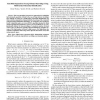Free Online Productivity Tools
i2Speak
i2Symbol
i2OCR
iTex2Img
iWeb2Print
iWeb2Shot
i2Type
iPdf2Split
iPdf2Merge
i2Bopomofo
i2Arabic
i2Style
i2Image
i2PDF
iLatex2Rtf
Sci2ools
TSP
2008
2008
Fast Blind Separation of Long Mixture Recordings Using Multivariate Polynomial Identification
This correspondence presents new approaches for optimizing kurtosis-based separation criteria in the case of long mixture recordings. Our methods are based on a multivariate polynomial identification step that avoids the computation of signal statistics at each step of the commonly used fixed-point optimization algorithms. As compared to the well-known FastICA algorithm and to our recent DFICA algorithm intended for blind partial separation of nonstationary sources, our new methods are very computationally efficient for long recordings of a moderate number of mixed sources. They are therefore especially suited to blind image separation, because of the high number of pixels in light sensors. Our algorithms also avoid the computation and storage of the sphered observation vector, thus saving memory space.
| Added | 16 Dec 2010 |
| Updated | 16 Dec 2010 |
| Type | Journal |
| Year | 2008 |
| Where | TSP |
| Authors | Johan Thomas, Yannick Deville, Shahram Hosseini |
Comments (0)

